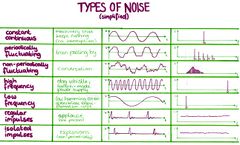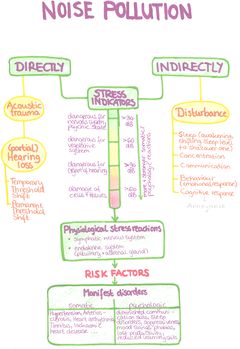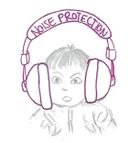Noise and noise unhealthiness
What is noise?[edit | edit source]
NOISE IS a sound, especially one that is loud or unpleasant or that causes disturbance.
Due to an increase of noise emission – especially unnatural artificial noise caused by traffic or industry - we talk about noise pollution. Therefore, noise is a subject of pollution control laws in many countries.
Sound is characterized by two quantities: acoustic pressure (in Pa) and frequency (in Hz). Noise is measured by sound pressure level (in dB). For more information: [1]
What we consider as noisy is influenced by
- subjective factors: mood, time of day,…
- objective factors: background noise level, type of noise (see table), frequency, time of exposure,…
- Noise sources: railway traffic, motor vehicles, manufacturing plants,…
- Noise from airports or sudden impulse noises are typically perceived as more bothersome than noise from traffic of equal volume.
Why is noise unhealthy?[edit | edit source]
Noise can lead to a wide range of health problems due to direct effects on the ear or indirect on the whole body (see picture). It’s even possible to die when exposed to sounds over 200 dB, because of alveolar bursting.
Any noise can be damaging, regardless of its intensity. The auditory nerve provides activating impulses to the brain. That enables us to regulate the vigilance but potentially disturbes physiological necessary recreation. The WHO guidelines for community noise recommends less than 30dB in bedrooms during the night for a sleep of good quality and less than 35dB in classrooms to allow good teaching and learning conditions. They also recommend less than 40dB of annual average night noise outside of bedrooms.
Some groups are more vulnerable to noise, for example children. They need more recreation time than adults, they are more exposed to night noise. Others are pregnant women, chronically ill and elderly people and shift workers.
Biological effects on the ear[edit | edit source]
High noise level for a short time have the same damaging effect like low noise level over a long period of time. Hearing impairment can begin at around 85dB. Once lost, hearing cannot be restored in humans. Some of these effects are:
- Mechanical damage after repeated or acute high intensity noise expose: noise-induced hearing loss (NIHL).
- Prolonged exposure > blood vessels in the ear constrict > lack of oxygen > stereocilia of inner and outer hair cells of the cochlea fuse, bent or break
- A very loud sound in a particular frequency range > damage of cochlea's hair cells that respond to that range > reduced ear's ability to hear those frequencies
- Very loud noise like explosions (large frequency range) have harmful effects across the entire range of human hearing > injuries of eardrum and displacement of auditory ossicles
- Presbycusis: age-related hearing-loss > cause: decreased flexibility of eardrum, auditory ossicles, etc.; fusing + breaking of stereocilia.
Biological and Psychosomatic effects on the body[edit | edit source]
Acute noise exposures activate the autonomic and hormonal systems, leading to temporary changes in organ systems. Depending on quality, quantity and time of exposure as well as mental and physiological condition of the person, different effects occur, e.g.:
- Cardiovascular diseases due to
- increased (nor)adrenalin concentration > increased blood pressure and heart rate, vasoconstriction
- shifts in electrolyte balance, blood viscosity
- increased blood glucose level
- changes in behavior, annoyance
Prevention and Protection[edit | edit source]
Prevention and raising awareness about the dangers of noise in general is paramount, as there are no treatments for curing hearing loss. This includes:
- Lowering the volume of sound at its source
- More distance from the source (sound intensity follows an inverse square: doubling the distance from a noise source reduces its intensity by a factor of four)
- Limiting the time of exposure
- Physical protection (barriers, sound absorbent materials)
Key-References[edit | edit source]
Books[edit | edit source]
Ekbert Hering, Rolf Martin, Martin Stohrer; Physik für Ingenieure; 3. edition; 1989; ISNB 3-18-400916-5
Frantisek Vítek; Lectures on biophysics with medical orientation; (edition not given); 2011; ISBN 978-80-246-2006-0
Webpages[edit | edit source]
WHO; http://www.who.int/docstore/peh/noise/guidelines2.html; last access: 14.11.2015
DUDEN Lernhelfer; https://www.lernhelfer.de/schuelerlexikon/biologie/artikel/laerm; last access: 17.11.2015
Lars Jarup; Marie-Louise Dudley; et al.; http://www.medscape.com/viewarticle/516462; last access: 17.11.2015
Additional references[edit | edit source]
Books[edit | edit source]
Werner Kahle, Michael Frotscher; Nervous System and Sensory Organs; 6th edition; 2010; ISBN 978-3-13-533506-3
Webpages[edit | edit source]
WHO; http://www.euro.who.int/en/health-topics/environment-and-health/noise/news/news/news?root_node_selection=238747; last access: 14.11.2015
Oxford Dictionaries; http://www.oxforddictionaries.com/de/definition/englisch_usa/noise; last access: 13.11.2015
Greg Johnson; http://www.upenn.edu/pennnews/current/2014-06-05/research/too-much-noise-bad-your-health; last access: 14.11.2015
WebMD, Healthwise; http://www.webmd.com/brain/tc/harmful-noise-levels-topic-overview, last access: 15.11.2015
Dr. Eberhard Greisner, Claudia Greisner, Epi.Consult GmbH, Musweiler; http://www.umweltbundesamt.de/uba-info-medien/mysql_medien.php?anfrage=Kennummer&Suchwort=3775; last access: 16.11.2015



